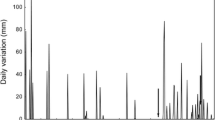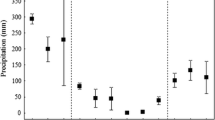Synopsis
Resource partitioning and the seasonal patterns of food intake of four characids (Astyanax fasciatus, A. bimaculatus, A. schubarti and Cheirodon stenodon) were studied during 1988 in a floodplain lake of Mogi-Guaçú River, Sao Paulo State. For interspecific comparisons, data of the previously studied Moenkhausia intermedia have also been used. A. fasciatus and A. bimaculatus can be considered omnivorous species, while A. schubarti and C. stenodon are predominantly herbivorous. The river flood cycle (following the wet season October-March and dry season April-September) seems to influence both seasonal food intake and food overlap between species. February-March and September-October are probably the months of highest food availability, and the months preceding these periods have the lowest resource amount. Our study shows that both omnivorous and herbivorous species modified the intensity of their interactions according to this cycle. Omnivorous species maintained fairly segregated diets when resources were presumably limited, and showed a rapid change from distinct food niches in the dry season to widely overlapping ones when resources were presumably more abundant. Conversely, the herbivorous species showed higher overlap during the dry season. Acute cyclic changes in the environment, as observed in this study, suggest the necessity of small interval sampling in food partitioning studies in tropical freshwater floodplains, in order to understand how species interact and cope with changes in food availability.
Similar content being viewed by others
References cited
Arcifa, M.S., T.G. Northcote & O. Froehlich. 1991. Interactive ecology of two cohabiting characin fishes (Astyanax fasciatus and Astyanax bimaculatus) in an eutrophic Brazilian reservoir. Jour. Trop. Ecol. 7: 257–268.
Barbosa, P.M.M. 1982. Predação de organismos zooplanctônicos pelo Astyanax fasciatus Cuvier, 1819 (Osteichtyes, Characidae) na Represa do Lobo (‘Broa’). M.Sc. Thesis, Universidade Federal de São Carlos (UFSCar), Sao Carlos. 128 pp.
Britski, H.A. 1964. Sbre uma nova espćie de Astyanax do Rio Mogi-Guassu (Pisces, Characidae). Papéis Avulsos do Departamento de Zoologia, Secretaria da Agricultura de São Paulo 16: 213–215.
Cavalheiro, F., M.V. Ballester, A.V. Krusche, S.A. Melo, J.L. Waechter, C.J. da Silva, M.C. D'Arienzo, M.S. Suzuki, R.L. Bozelli, T.P. Jesus & J.E. Santos. 1990. Propostas preliminares referentes ao plano de zoneamento da Estação Ecológica do Jataí. Acta Limnologica Brasiliensia 3: 951–968.
Esteves, K.E. 1992. Alimentação de cinco espécies forrageiras (Pisces, Characidae) em uma lagoa marginal do Rio Mogi-Guaçú, SP. Ph.D. Thesis, Universidade Federal de São Carlos (UFSCar), São Carlos. 230 pp.
Esteves, K.E. 1994. Feeding ecology of Moenkhausia intermedia (Pisces, Characidae) in a small oxbow lake of Mogi-Guaçú River, São Paulo, Brazil. Verh. Internat. Verein. Limnol. 522: 3973–3980.
Galetti Jr., K.E. Esteves, N.R.W. Lima, C.A. Mestriner, M.M. Cavallini, A.C.G. Cesar & C.S. Miyazawa. 1990. Aspectos comparativos da ictiofauna de duas lagoas marginais do Rio Mogi-Guaçú (Alto Paraná — Estação Ecológica do Jataí, SP). Acta Limnologica Brasiliensia 3: 865–885.
Galvão, M.V. 1976. Regiões bioclimáticas do Brasil. Revista Brasileira de Geografia 29: 3–36.
Goulding, M. 1980. The fishes and the forest: explorations in Amazonian natural history. University of California Press, Berkeley, 280 pp.
Hinegardner, R. & D.E. Rosen. 1972. Cellular DNA content and evolution of teleostean fishes. Amer. Nat. 106: 621–644.
Hyslop, E.J. 1980. Stomach content analysis — a review of methods and their application. J. Fish. Biol. 17: 411–429.
Junk, W.J. 1980. Areas inundáveis — um desafio para a limnologia. Acta Amaznica 10: 775–795.
Junk, W.J. 1985. Temporary fat storage, an adaptation of some fish species to waterlevel fluctuations and related environmental changes of the Amazon system. Amazoniana 9: 315–351.
Junk, W.J., P. Bayley & R.E. Sparks. 1989. The flood pulse concept in river-floodplain systems. pp. 110–127. In: D.P. Dodge (ed.) Proceedings of the International Large River Symposium (LARS), Can. Spec. Publ. Fish. Aquat. Sci. 106.
Kirpichnikov, V.S. 1981. The evolution of karyotypes among Cyclostomata and fishes. pp. 19–34. In: V.S. Kirpichnikov (ed.) Genetic Bases of Fish Selection, Springer Verlag, New York.
Lowe-McConnell, R.H. 1964. The fishes of the Rupununi savanna district of British Guiana, South America. Part I. Ecological groupings of fish species and effects of seasonal cycles on the fish. J. Linn. Soc. London (Zool.) 45: 103–144.
Machado-Allison, A. 1990. Ecologia dos peixes das áreas inundáveis dos lhanos da Venezuela. Intercincia 15: 411–423.
Morelli, S., L.A.C. Bertollo, F. Foresti, O. Moreira Filho & S.A. Toledo Filho. 1983. Cytogenetic considerations on the genus Astyanax (Pisces, Characidae). I. Karyotypic variability. Caryologia 36: 235–244.
Nogueira, F.M.B. 1989. Importância das macrófitas aquáticas Eichhornia azurea Kunth e Scirpus cubensis Poepp & Kunth na ciclagem de nutrientes e nas principais características limnológicas da Lagoa do Infernão (SP). M.Sc. Thesis, Universidade Federal de São Carlos (UFSCar), São Carlos. 147 pp.
Paixão, I.M.P. 1980. Estudo da alimentação e reprodução de Mylossoma duriventris Cuvier, 1818 (Pisces, Characoidei) do lago Janauacá, AM, Brasil. M.Sc. Thesis, Instituto de Pesquisas da Amazônia (INPA), Fundação Universidade do Amazonas (FUA), Manaus. 127 pp.
Portela, A.L.B.S., P.M. Galetti Jr. & L.A.C. Bertollo. 1988. Considerations on the chromosome evolution of Tetragonopterinae (Pisces, Characidae). Revista Brasileira de Genética 11: 307–316.
Power, M. 1983. Grazing responses of tropical freshwater fishes to different scales of variation in their food. Env. Biol. Fish. 9: 103–115.
Prejs, A. & K. Prejs. 1987. Feeding of tropical freshwater fishes: seasonality in resource availability and resource use. Oecologia 71: 397–404.
Ross, S.T. 1986. Resource partitioning in fish assemblages: a review of field studies. Copeia 1986: 352–388.
Schoener, T.W. 1974. Resource partitioning in ecological communities. Science 185: 27–39.
Toledo-Filho, D.V 1984. Composição florística e estrutura fitossociológica da vegetaçào do Município de Luis Antoio (SP). M.Sc. Thesis, Universidade Estadual de Campinas, Campinas. 173 pp.
Zaret, T.M. & A.S. Rand. 1971. Competition in tropical stream fishes: support for the competitive exclusion principle. Ecology 52: 336–342.
Author information
Authors and Affiliations
Rights and permissions
About this article
Cite this article
Esteves, K.E., Galetti, P.M. Food partitioning among some characids of a small Brazilian floodplain lake from the Paraná River basin. Environ Biol Fish 42, 375–389 (1995). https://doi.org/10.1007/BF00001468
Received:
Accepted:
Issue Date:
DOI: https://doi.org/10.1007/BF00001468




